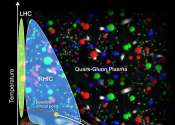Recognizing a clear sign that quark-gluon plasma production 'turns off' at low energy
Physicists report new evidence that production of an exotic state of matter in collisions of gold nuclei at the Relativistic Heavy Ion Collider (RHIC)—an atom-smasher at the U.S. Department of Energy's (DOE) Brookhaven ...









